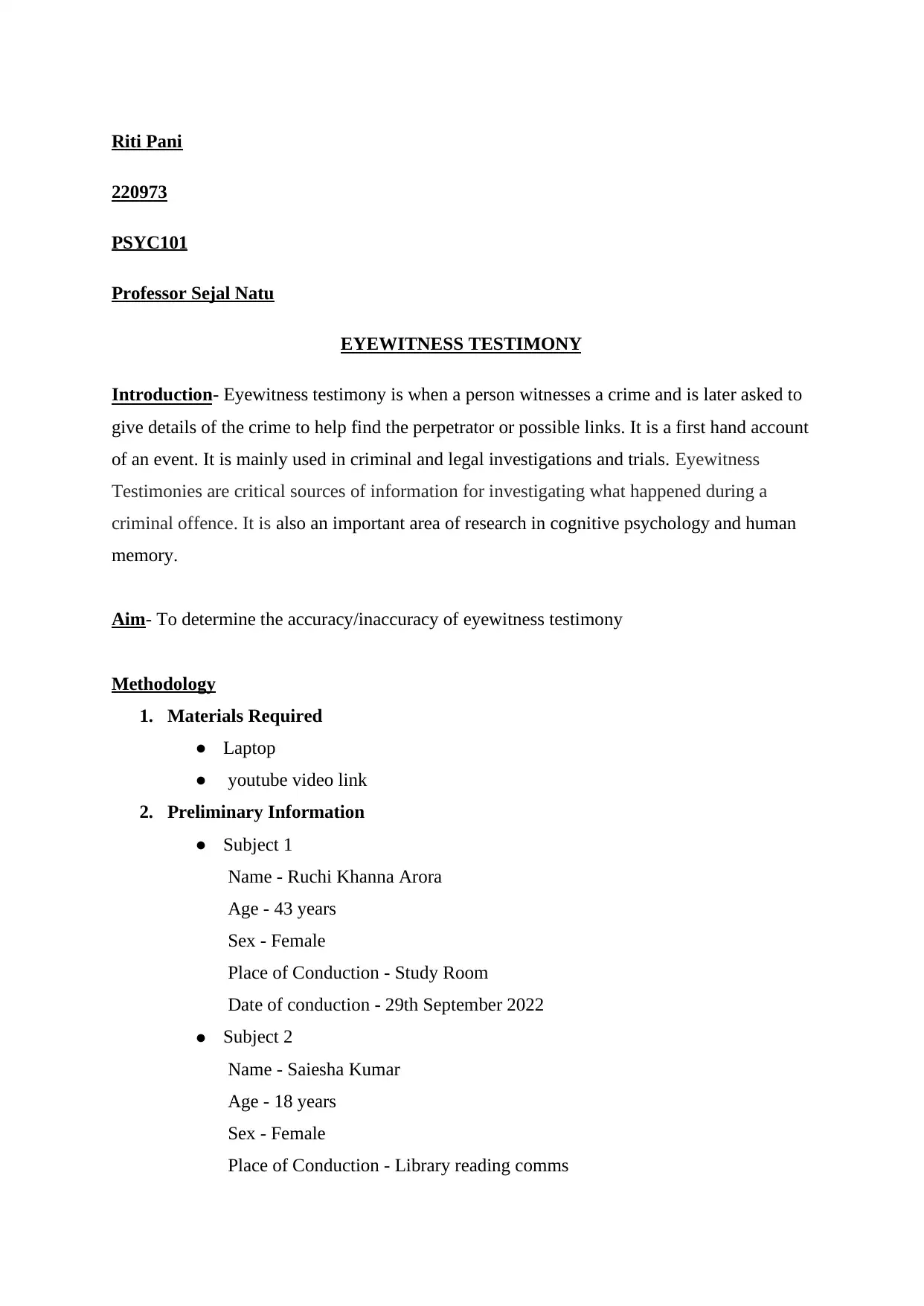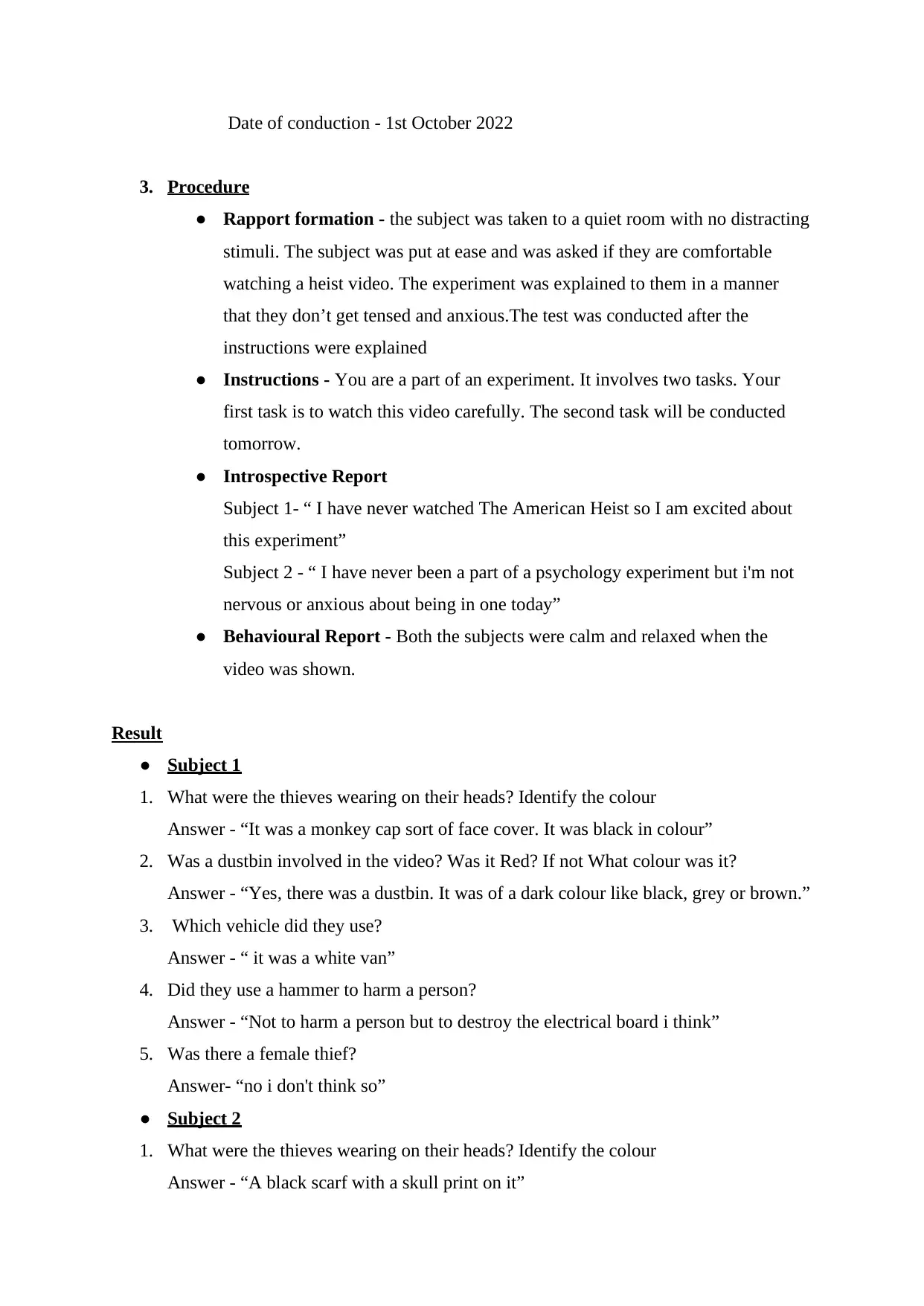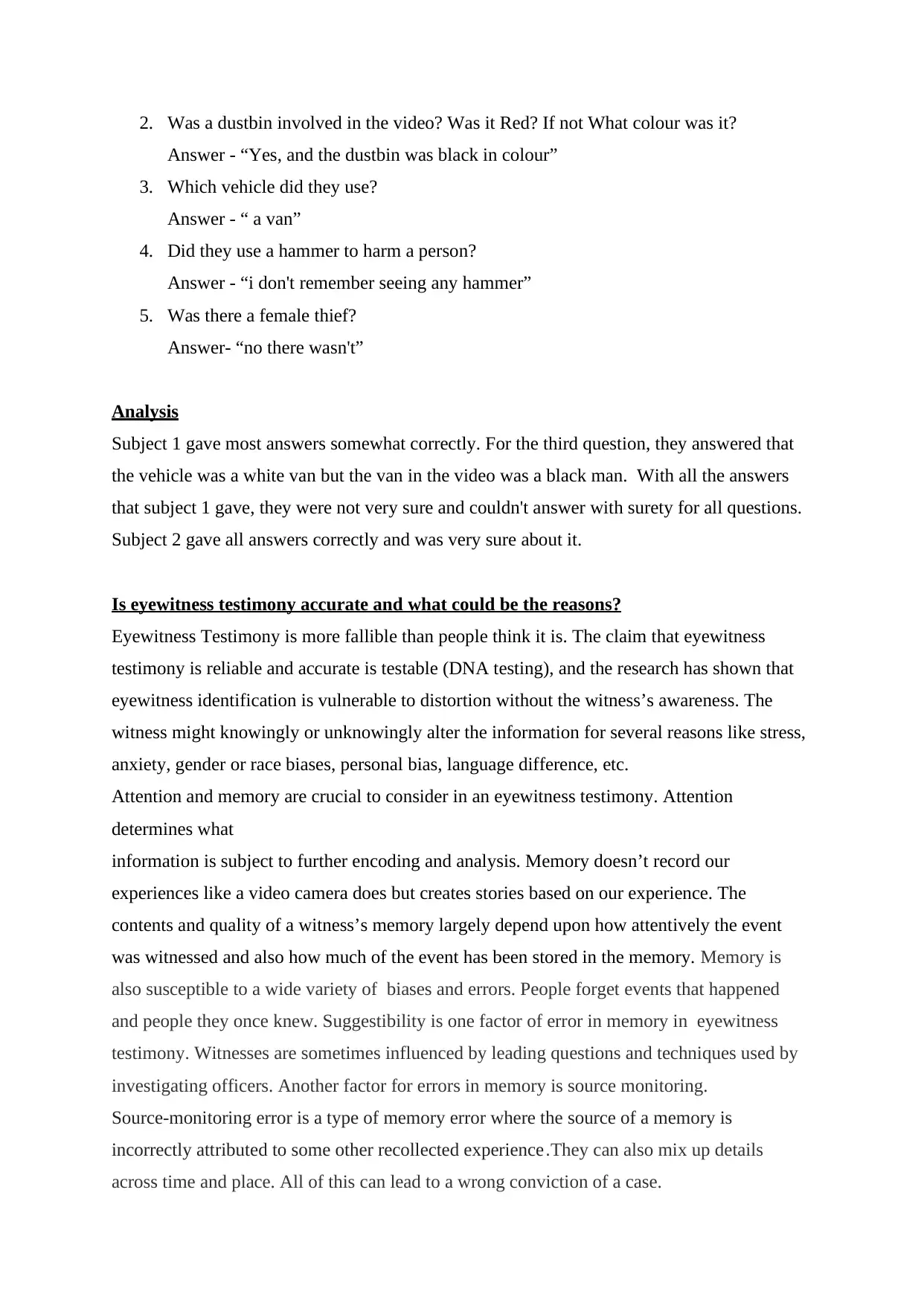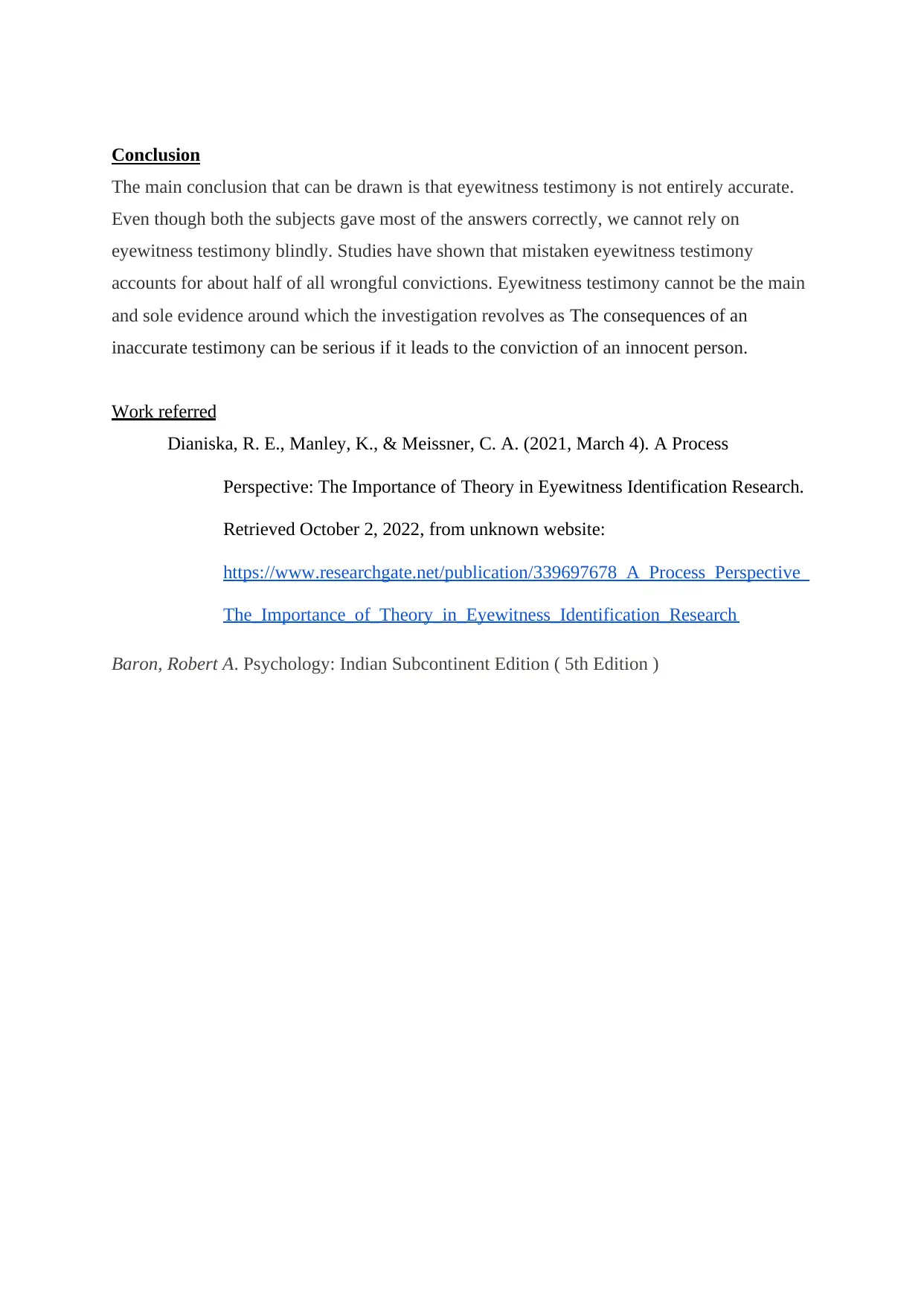PSYC101: Analysis of Eyewitness Testimony and Accuracy
VerifiedAdded on 2023/01/09
|4
|1088
|52
Homework Assignment
AI Summary
This psychology assignment, conducted for PSYC101, investigates the accuracy of eyewitness testimony. The methodology involved two subjects watching a heist video and answering questions about it. The results revealed variations in recall accuracy between the subjects, highlighting the fallibility of human memory. The analysis delves into factors affecting eyewitness testimony, such as attention, memory biases, suggestibility, and source monitoring errors. The conclusion emphasizes that eyewitness testimony is not entirely accurate and should not be the sole basis for investigations, as inaccurate testimonies can lead to wrongful convictions. The assignment also references relevant research on eyewitness identification.

Riti Pani
220973
PSYC101
Professor Sejal Natu
EYEWITNESS TESTIMONY
Introduction- Eyewitness testimony is when a person witnesses a crime and is later asked to
give details of the crime to help find the perpetrator or possible links. It is a first hand account
of an event. It is mainly used in criminal and legal investigations and trials. Eyewitness
Testimonies are critical sources of information for investigating what happened during a
criminal offence. It is also an important area of research in cognitive psychology and human
memory.
Aim- To determine the accuracy/inaccuracy of eyewitness testimony
Methodology
1. Materials Required
● Laptop
● youtube video link
2. Preliminary Information
● Subject 1
Name - Ruchi Khanna Arora
Age - 43 years
Sex - Female
Place of Conduction - Study Room
Date of conduction - 29th September 2022
● Subject 2
Name - Saiesha Kumar
Age - 18 years
Sex - Female
Place of Conduction - Library reading comms
220973
PSYC101
Professor Sejal Natu
EYEWITNESS TESTIMONY
Introduction- Eyewitness testimony is when a person witnesses a crime and is later asked to
give details of the crime to help find the perpetrator or possible links. It is a first hand account
of an event. It is mainly used in criminal and legal investigations and trials. Eyewitness
Testimonies are critical sources of information for investigating what happened during a
criminal offence. It is also an important area of research in cognitive psychology and human
memory.
Aim- To determine the accuracy/inaccuracy of eyewitness testimony
Methodology
1. Materials Required
● Laptop
● youtube video link
2. Preliminary Information
● Subject 1
Name - Ruchi Khanna Arora
Age - 43 years
Sex - Female
Place of Conduction - Study Room
Date of conduction - 29th September 2022
● Subject 2
Name - Saiesha Kumar
Age - 18 years
Sex - Female
Place of Conduction - Library reading comms
Paraphrase This Document
Need a fresh take? Get an instant paraphrase of this document with our AI Paraphraser

Date of conduction - 1st October 2022
3. Procedure
● Rapport formation - the subject was taken to a quiet room with no distracting
stimuli. The subject was put at ease and was asked if they are comfortable
watching a heist video. The experiment was explained to them in a manner
that they don’t get tensed and anxious.The test was conducted after the
instructions were explained
● Instructions - You are a part of an experiment. It involves two tasks. Your
first task is to watch this video carefully. The second task will be conducted
tomorrow.
● Introspective Report
Subject 1- “ I have never watched The American Heist so I am excited about
this experiment”
Subject 2 - “ I have never been a part of a psychology experiment but i'm not
nervous or anxious about being in one today”
● Behavioural Report - Both the subjects were calm and relaxed when the
video was shown.
Result
● Subject 1
1. What were the thieves wearing on their heads? Identify the colour
Answer - “It was a monkey cap sort of face cover. It was black in colour”
2. Was a dustbin involved in the video? Was it Red? If not What colour was it?
Answer - “Yes, there was a dustbin. It was of a dark colour like black, grey or brown.”
3. Which vehicle did they use?
Answer - “ it was a white van”
4. Did they use a hammer to harm a person?
Answer - “Not to harm a person but to destroy the electrical board i think”
5. Was there a female thief?
Answer- “no i don't think so”
● Subject 2
1. What were the thieves wearing on their heads? Identify the colour
Answer - “A black scarf with a skull print on it”
3. Procedure
● Rapport formation - the subject was taken to a quiet room with no distracting
stimuli. The subject was put at ease and was asked if they are comfortable
watching a heist video. The experiment was explained to them in a manner
that they don’t get tensed and anxious.The test was conducted after the
instructions were explained
● Instructions - You are a part of an experiment. It involves two tasks. Your
first task is to watch this video carefully. The second task will be conducted
tomorrow.
● Introspective Report
Subject 1- “ I have never watched The American Heist so I am excited about
this experiment”
Subject 2 - “ I have never been a part of a psychology experiment but i'm not
nervous or anxious about being in one today”
● Behavioural Report - Both the subjects were calm and relaxed when the
video was shown.
Result
● Subject 1
1. What were the thieves wearing on their heads? Identify the colour
Answer - “It was a monkey cap sort of face cover. It was black in colour”
2. Was a dustbin involved in the video? Was it Red? If not What colour was it?
Answer - “Yes, there was a dustbin. It was of a dark colour like black, grey or brown.”
3. Which vehicle did they use?
Answer - “ it was a white van”
4. Did they use a hammer to harm a person?
Answer - “Not to harm a person but to destroy the electrical board i think”
5. Was there a female thief?
Answer- “no i don't think so”
● Subject 2
1. What were the thieves wearing on their heads? Identify the colour
Answer - “A black scarf with a skull print on it”

2. Was a dustbin involved in the video? Was it Red? If not What colour was it?
Answer - “Yes, and the dustbin was black in colour”
3. Which vehicle did they use?
Answer - “ a van”
4. Did they use a hammer to harm a person?
Answer - “i don't remember seeing any hammer”
5. Was there a female thief?
Answer- “no there wasn't”
Analysis
Subject 1 gave most answers somewhat correctly. For the third question, they answered that
the vehicle was a white van but the van in the video was a black man. With all the answers
that subject 1 gave, they were not very sure and couldn't answer with surety for all questions.
Subject 2 gave all answers correctly and was very sure about it.
Is eyewitness testimony accurate and what could be the reasons?
Eyewitness Testimony is more fallible than people think it is. The claim that eyewitness
testimony is reliable and accurate is testable (DNA testing), and the research has shown that
eyewitness identification is vulnerable to distortion without the witness’s awareness. The
witness might knowingly or unknowingly alter the information for several reasons like stress,
anxiety, gender or race biases, personal bias, language difference, etc.
Attention and memory are crucial to consider in an eyewitness testimony. Attention
determines what
information is subject to further encoding and analysis. Memory doesn’t record our
experiences like a video camera does but creates stories based on our experience. The
contents and quality of a witness’s memory largely depend upon how attentively the event
was witnessed and also how much of the event has been stored in the memory. Memory is
also susceptible to a wide variety of biases and errors. People forget events that happened
and people they once knew. Suggestibility is one factor of error in memory in eyewitness
testimony. Witnesses are sometimes influenced by leading questions and techniques used by
investigating officers. Another factor for errors in memory is source monitoring.
Source-monitoring error is a type of memory error where the source of a memory is
incorrectly attributed to some other recollected experience.They can also mix up details
across time and place. All of this can lead to a wrong conviction of a case.
Answer - “Yes, and the dustbin was black in colour”
3. Which vehicle did they use?
Answer - “ a van”
4. Did they use a hammer to harm a person?
Answer - “i don't remember seeing any hammer”
5. Was there a female thief?
Answer- “no there wasn't”
Analysis
Subject 1 gave most answers somewhat correctly. For the third question, they answered that
the vehicle was a white van but the van in the video was a black man. With all the answers
that subject 1 gave, they were not very sure and couldn't answer with surety for all questions.
Subject 2 gave all answers correctly and was very sure about it.
Is eyewitness testimony accurate and what could be the reasons?
Eyewitness Testimony is more fallible than people think it is. The claim that eyewitness
testimony is reliable and accurate is testable (DNA testing), and the research has shown that
eyewitness identification is vulnerable to distortion without the witness’s awareness. The
witness might knowingly or unknowingly alter the information for several reasons like stress,
anxiety, gender or race biases, personal bias, language difference, etc.
Attention and memory are crucial to consider in an eyewitness testimony. Attention
determines what
information is subject to further encoding and analysis. Memory doesn’t record our
experiences like a video camera does but creates stories based on our experience. The
contents and quality of a witness’s memory largely depend upon how attentively the event
was witnessed and also how much of the event has been stored in the memory. Memory is
also susceptible to a wide variety of biases and errors. People forget events that happened
and people they once knew. Suggestibility is one factor of error in memory in eyewitness
testimony. Witnesses are sometimes influenced by leading questions and techniques used by
investigating officers. Another factor for errors in memory is source monitoring.
Source-monitoring error is a type of memory error where the source of a memory is
incorrectly attributed to some other recollected experience.They can also mix up details
across time and place. All of this can lead to a wrong conviction of a case.
⊘ This is a preview!⊘
Do you want full access?
Subscribe today to unlock all pages.

Trusted by 1+ million students worldwide

Conclusion
The main conclusion that can be drawn is that eyewitness testimony is not entirely accurate.
Even though both the subjects gave most of the answers correctly, we cannot rely on
eyewitness testimony blindly. Studies have shown that mistaken eyewitness testimony
accounts for about half of all wrongful convictions. Eyewitness testimony cannot be the main
and sole evidence around which the investigation revolves as The consequences of an
inaccurate testimony can be serious if it leads to the conviction of an innocent person.
Work referred
Dianiska, R. E., Manley, K., & Meissner, C. A. (2021, March 4). A Process
Perspective: The Importance of Theory in Eyewitness Identification Research.
Retrieved October 2, 2022, from unknown website:
https://www.researchgate.net/publication/339697678_A_Process_Perspective_
The_Importance_of_Theory_in_Eyewitness_Identification_Research
Baron, Robert A. Psychology: Indian Subcontinent Edition ( 5th Edition )
The main conclusion that can be drawn is that eyewitness testimony is not entirely accurate.
Even though both the subjects gave most of the answers correctly, we cannot rely on
eyewitness testimony blindly. Studies have shown that mistaken eyewitness testimony
accounts for about half of all wrongful convictions. Eyewitness testimony cannot be the main
and sole evidence around which the investigation revolves as The consequences of an
inaccurate testimony can be serious if it leads to the conviction of an innocent person.
Work referred
Dianiska, R. E., Manley, K., & Meissner, C. A. (2021, March 4). A Process
Perspective: The Importance of Theory in Eyewitness Identification Research.
Retrieved October 2, 2022, from unknown website:
https://www.researchgate.net/publication/339697678_A_Process_Perspective_
The_Importance_of_Theory_in_Eyewitness_Identification_Research
Baron, Robert A. Psychology: Indian Subcontinent Edition ( 5th Edition )
1 out of 4
Your All-in-One AI-Powered Toolkit for Academic Success.
+13062052269
info@desklib.com
Available 24*7 on WhatsApp / Email
![[object Object]](/_next/static/media/star-bottom.7253800d.svg)
Unlock your academic potential
Copyright © 2020–2025 A2Z Services. All Rights Reserved. Developed and managed by ZUCOL.